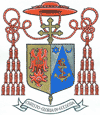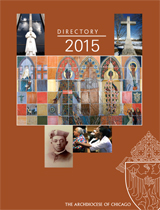
The Cardinal’s Column
Francis Cardinal George, O.M.I.
January 20, 2008
Jerusalem: Golden and conflicted
Cardinal George's Schedule
- Jan. 21-22: March for Life, Washington, D.C.
- Jan. 29: 9 a.m., The Chicago Project for Violence Prevention Awards Breakfast, UIC; 1 p.m., Administrative Council Meeting, Pastoral Center; 7:30 p.m., Meeting with Hispanic Permanent Deacon Candidates, Pastoral Center
- Jan. 31: 10:30 a.m., Catholic Church Extension Society Executive Committee Meeting, Residence; 6 p.m., Pastoral Visit, Amate House
- Feb. 1: 9:30 a.m., 80th Anniversary Mass, Our Lady of Tepeyac High School
- Feb. 2: 9 a.m., Parish Pastoral Councils Leadership Day, Guerin College Preparatory High School

Cardinal's Appointments
January 14 , 2008
His Eminence, Francis Cardinal George announces the following appointments:
Pastor
Rev. Stanislaw Jankowski, C.R., to be the pastor of St. Hedwig Parish, North Hoyne, effective immediately.
Rev. James Merold, from sabbatical, to be the pastor of St. Gabriel Parish, South Wallace, effective immediately.
Associate pastor
Rev. J. Eduardo Martinez Solis, from associate pastor of St. Colette Parish, Rolling Meadows, to be the associate pastor of St. Mary of Vernon Parish, Indian Creek, effective immediately.
Administrator
Rev. Philip Dressler, from administrator of Queen of the Rosary Parish, Elk Grove Village, to administrator of St. Mary of Perpetual Help Parish, West 32nd Street, effective immediately.
Rev. Joseph Ruiz, from associate pastor of Most Holy Redeemer Parish, Evergreen Park, to be the administrator of the same, effective immediately.
Pastor emeritus
Rev. William A. Burke, from resident of St. Julie Billiart Parish, Tinley Park, to retire after 42 years of service to the Church, and be pastor emeritus of St. Cajetan Parish, West 112th Street, effective Feb. 1.
Rev. John Thinnes, from associate pastor of Our Lady of Perpetual Help Parish, Glenview, to retire after 44 years of service to the Church, and be Pastor Emeritus of Holy Cross Parish, Deerfield, effective immediately.
Sabbatical
Rev. Richard LoBianco, from pastor of St. Gerald Parish, Oak Lawn, to be on sabbatical until June 15, effective immediately.
Dear Brothers and Sisters in Christ: I am writing this column in Jerusalem, a city that gleams like gold when the sun lights up its walls and its stone buildings. The presidents or representatives of the United States, Canadian and European Catholic Bishops’ Conferences have come to pay a pastoral visit to Catholics living in the State of Israel and in the territories governed by the Palestinian Authority.
Before the pastoral visit with other Catholic leaders began, I visited Catholics living in Fassouta, a small town in Galilee whose people are all Melkite Catholics.
In 2004, I mentioned to a number of Jewish friends in Chicago that Arab Catholics were leaving Israel in great numbers, largely because of the uncertainty of their economic future. In response, the Jewish Federation of Chicago generously proposed that they and the Archdiocese of Chicago cosponsor a project that would offer hope by helping the people of Fassouta to develop computer skills. The project was launched in 2005 and has proven to be a great success.
When I visited Fassouta with a rabbi from Chicago, the mayor and the representative of the Chicago Jewish Federation, who acts as liaison, took me first to the village well that the apostle Paul is supposed to have blessed when he passed through the area 2,000 years ago and then to the Cultural Center where the computer learning project is housed.
Besides the computers and the instruction in their use, the Center also serves as an artistic learning facility that has enriched the social life of the town. After talking to the youngsters using the computers and watching a presentation by the students of ballet, we visited the parish church, dedicated to St. Elijah the prophet, and talked with the two parish priests and many of the parishioners. We exchanged gifts from our respective towns and enjoyed legendary Arab hospitality.
In a land marked by separation and hostilities of all kinds, it was a great pleasure to visit a place where people are eager to remain and are very appreciative of a modest project that seems to have made a great difference in their lives. Those we talked to in Fassouta are Byzantine in their liturgy, Catholic in religious communion, Arab in their language and culture and citizens of a Jewish state. They bring it all together very well.
Hope is fragile, and where it flowers everyone has reason to be joyful. I am most grateful to the Chicago Jewish Federation and to those who arranged my visit to Fassouta and to several other places in Israel.
Other sites
In the short space of two days, I also visited the inexpressibly moving Yad Vashem Holocaust History Museum; saw in place in Megiddo a recently uncovered second-century mosaic with inscriptions and symbols that identify it as the floor of a house chapel in a Roman army officer’s home at a time when the Church was being publicly persecuted in the Roman Empire; visited recent archaeological finds of purification pools outside the Temple where Jesus came on pilgrimage; and, at the beginning of the Sabbath, went up to Mount Zion to pray at the Western Wall of the Temple Mount.
Through the kindness of local Jewish scholars, I was updated on the work of the Hebrew University Bible Project, a careful task that searches through every available bit of textual evidence in order to construct a biblical manuscript as faithful as possible to the books originally written by the prophets and other human authors.
Since the inspired and inerrant texts are only those in the original language, establishing the original text as closely as possible is of great importance in our coming to understand the meaning of the Bible.
Nobody likes a wall
Two days into my visit, I joined the meeting of those who had come in support of the Church of the Holy Land. On our first day together, reports from the Latin patriarch of Jerusalem, the papal nuncio and some members of the diplomatic corps stationed in Jerusalem were complemented by a visit to Bethlehem University, conducted by the Christian Brothers. It is the only Catholic university in the Holy Land.
We talked at some length with young people, Palestinian Christians and Muslims, studying there. Their worry about the future was less immediate to them than was the affront to their human dignity and to human communication represented by the serpentine path of the security wall that the Israeli government has built in order to prevent terrorist attacks.
Nobody likes a wall, and the Israelis insist it will come down when permanent boundaries are put in place by a peace treaty. Many of the Palestinians are unconvinced. Many on both sides seem not to believe it possible to achieve a negotiated peace in the near future.
Achieving just such a peace was the purpose of President Bush’s visit the week I was in the Holy Land. Officially, his efforts were appreciated; unofficially, on both sides of the dispute, many were skeptical.
ʻWelcome and friendliness’
For thousands of years, believers in the God of Abraham, Isaac and Jacob have prayed for the peace of Jerusalem. I prayed for such peace in a particularly intense way during Mass on the feast of the Baptism of the Lord. I celebrated Mass that Sunday at Holy Family Parish in Ramallah, a city with a fairly strong Palestinian Christian presence and with, as well, the headquarters of the Palestinian Authority.
The Mass was in Latin, which I can handle, and Arabic, which I can’t. But the welcome and the friendliness were marked by the unity of all those in Catholic communion. I promised the parishioners that I would remain united with them in prayer, and asked for their prayers in turn.
Praying anywhere is to embark on a pilgrimage along a path set by God for each one of us. Praying in the Holy Land, especially praying the Psalms, brings with it a sense of walking closely with Jesus himself on the earthly pilgrimage that brought him from Bethlehem to Egypt to Nazareth to Capernaum, through Galilee and Samaria to Jerusalem, where he suffered, died, was buried and rose from the dead.
These are the places where the judges, the prophets and kings and many thousands of the Chosen People walked with God over the centuries. These are the places where Peter and the other apostles, filled with the Holy Spirit, set out on mission, on a pilgrimage that now brings together in faith Jerusalem and Chicago, Berwyn and Antioch and all the towns of Cook and Lake counties and all around the globe where believers acknowledge Jesus as Lord and are visibly gathered into Catholic communion.
Catholicism is a global society, and to pray in the Holy Land is to experience anew this unity everywhere and across the ages. Such prayer converts each of us to the ways of the Lord.
The often tortured history of the Holy Land and the Scriptures themselves bear witness to the mystery of God’s ways. In the midst of historical tragedies and holding in their hearts the mysteries of faith, believers repeat in every age: “Those who trust in the Lord are like Mount Zion that cannot be moved, enduring forever. Jerusalem, hills enfold it, and the Lord enfolds his people now and forever” (Ps 125).
In the Holy Land, I prayed for the priests, deacons, seminarians (some of whom are studying this semester in Jerusalem), religious women and men and lay faithful of our archdiocese. If we do what the prophet Micah (6:8) says the Lord requires of us — to do justice and love goodness and walk modestly with God — then “the Lord will do great things for us and we shall rejoice” (Ps 126).
May the God of Abraham, Isaac and Jacob, the Father of Our Lord and Savior Jesus Christ bless you and bring joy to your hearts.
Sincerely yours in Christ,
Francis Cardinal George, OMI
Archbishop of Chicago
 Catholic
New World - Newspaper for the Archdiocese of Chicago
Catholic
New World - Newspaper for the Archdiocese of Chicago Archdiocese of Chicago Directory
Archdiocese of Chicago Directory Oficjalne wydawnictwo Archidiecezji Chicago w języku polskim
Oficjalne wydawnictwo Archidiecezji Chicago w języku polskim